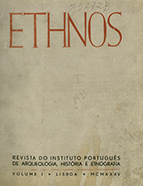

................................
The journal was consistently published in Lisbon, typically printed at a press located on Rua das Gáveas in Bairro Alto. Initially, it relied on contributions from IAHE members, but later editions were heavily sponsored by the Fundação Calouste Gulbenkian [Calouste Gulbenkian Foundation] (the 1965 edition includes a photograph of Calouste Gulbenkian) and the Secretary of State for Culture (1979). There are no available records of the journal's circulation, but considering the specialised topics it addressed and the IAHE's well-documented financial difficulties throughout its existence, it is unlikely to have been widely distributed. Similarly, no references to the publication’s price have been found.
The journal primarily focused on archaeological, historical, and ethnographic themes, adhering to the principles of the Methodical School of historiography, which often included facsimile reproductions of individual documents. Clearly intended for an erudite audience specialising in these fields, it was not designed as a commercial or advertising publication in any sense. This scientific periodical aims to update readers on the results of archaeological expeditions in Portugal (including contributions from foreign authors), present ethnographic field research, explore historiographical topoi primarily centred on the period of Portuguese Expansion, and, to a lesser extent, debate philological nuances.
Its publication schedule was highly irregular, with only eight issues released between 1935 ( terminus a quo ) and 1979 ( terminus ad quem ). Notably, no explicit mention of its intended periodicity appears in any of the issues or the statutes of the institute to which it belonged. Its publication seems to have depended entirely on the sustained efforts of Manuel Heleno and, on two occasions, on academic tributes following the deaths of significant figures: Leite de Vasconcelos (commemorated in the 1942 edition, with continued mentions in the subsequent 1948 issue) and Manuel Heleno himself (honoured in 1970, the year of his death). From 1965 onwards, efforts were made to regularise its publication, resulting in four issues being released over five years (1965, 1966, 1969, and 1970). This may reflect Heleno's realisation of the journal's subordinate status as a tribute to his mentor, Leite de Vasconcelos, as well as his changing professional circumstances after leaving the Faculty of Letters at the University of Lisbon in 1964.
This work is financed by national funds through FCT - Foundation for Science and Technology, I.P, in the scope of the projects UIDB/04311/2020 and UIDP/04311/2020.
